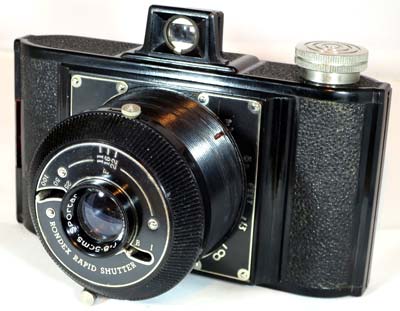Truvox Wembley Sports
Specification

| Manufacturer | : | Truvox |
|---|---|---|
| Produced | : | 1950 |
| Classification | : | Medium Format |
| Body Type | : | Extending Helicoid |
| Construction | : | Bakelite |
| Film Type | : | 120 |
| Film Width | : | 62mm |
| ImageSize | : | 2¼ x 3¼ in |
| No. of Images | : | 8 |
| Lens Type | : | Meniscus |
| Focal Length | : | 85mm |
| Focus Type | : | Variable |
| Focal Range | : | 4ft - inf. |
| Aperture Type | : | Variable Stops |
| Aperture | : | f/11, f/16, f/22 |
| Shutter Type | : | Guillotine type |
| Shutter Speeds | : | B, I*(1/25s 1/50s, 1/100s) |
| Size open(w x h x d) | : | 160 x 105 x 100 mm |
| Size closed(w x h x d) | : | 160 x 105 x 70 mm |
| Weight | : | 418g |
Art Deco Credentials
![]()
![]()
Acceptable: Modest and restricted
- Body shape designed after the main Art Deco period.
- Polished and patterned Bakelite
- Curvilinear body design
- Stepped body design
- Chrome Film advance knob
- Chrome lettering on lens faceplate
Description

The Wembley Sports is a Bakelite camera made in England by Truvox. It was named after Truvox's address at Wembley, London. It was introduced in 1950 and takes eight 6x9cm images on 120 film. The Artima Arti-Six and French labelled Grand Manitou are very similar cameras which were produced by Truvox for Artima Export Ltd. At the end of the 1948-50 production run of Arti-Six cameras, Truvox continued from 1950 to 1956 with the Wembley Sports using moulds and tooling from the production of the Arti-Six. Both these 120 rollfilm cameras bear a close resemblance to the smaller Artima Photo-Magic which takes 127 (VP) size film.
Focussing is achieved by turning the whole lens unit which screws in and out of the body (helical focussing) with click-stops marked on the camera body at 4ft, 6ft, 13ft and infinity. The lens screws into the body when not in use. It has a curved film plane which allows sharper focussing in the corners of the frame.
The lens is an 85mm f/11 London Sportar, stopping down to f/16 and f/22. The B/I shutter covers speeds of 1/25s, 1/50s and 1/100s. It has a reverse Galilean viewfinder.
It is a fairly robust camera weighing in at 418g.
How to Use
The film is loaded by simply pulling open the back.
Shutter speeds are 1/25s, 1/50s and 1/100s although the accuracy is not guaranteed.
If you don't want to bother with an exposure meter, follow the guide shown. It is based on the 'Sunny 16' rule. Film is so forgiving and will produce acceptable results even when overexposed by 2 or 3 stops or underexposed by 1 stop.
Remember that the exposure guide that is found on the camera may not be helpful as it is based on the use of old film with a low ISO value.
The tables assume that the sun is at least 30 degrees above the horizon - that's 10am - 5pm on a summer's day in the UK.
If you are not sure about the light level, err on the side of overexposure - i.e. assume the smaller f number.
Where there is a choice, a larger f number will give a larger depth of field.
For the slower speeds, you may need a tripod to stop blur through shake.
Using ISO 100/125 film
| Weather Conditions | Shadow Detail | Shutter Speed (s) | ||
|---|---|---|---|---|
| 1/25 | 1/50 | 1/100 | ||
 Sunny SunnySnow/Sand | Dark with sharp edges | - | - | f/22 |
 Sunny Sunny | Distinct | - | f/22 | f/16 |
 Slight Overcast Slight Overcast | Soft around edges | f/22 | f/16 | f/11 |
 Overcast Overcast | Barely visible | f/16 | f/11 | - |
 Heavy Overcast Heavy Overcast | None | f/11 | - | - |
 Open Shade Open Shade/Sunset | None | - | - | - |